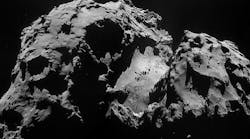The European Space Agency’s (ESA) Rosetta mission, established to seek the origin of comets, is currently studying comet 67P to create a portrait of its nucleus, makeup, and orbit around the sun. The ESA recently announced it will work with the Qt Company to develop a 3D-rendering software module as part of the ESA’s Mapping and Planning of Payload Science (MAPPS) tool. To date, developing such software has proven difficult in terms of meeting the mission’s goals due to the irregularity of comets, which makes them unsuitable for modeling as flattened spheres (the typical approach taken with planetary missions).
A two-step approach will be taken to render the elements required in creating a 3D model of the comet. First, the elements will be rendered on a texture map representing the surface of the comet, and that includes its irregular shape. That texture will then be sent to the MAPPS tool, which will apply it to the surface of the 3D model to allow for planning and data analytics. The ESA chose Qt Company as a partner due to its development framework—it enables rapid development and supports GPU hardware acceleration, a necessity for complex 3D rendering software.
Watch the video below, courtesy of the ESA, for highlights from the Rosetta mission’s soft-landing of the Philae probe on the comet:
Qt, a cross-platform application and UI framework, can be used for embedded device creation and application development. UI can be developed with Qt Quick (written with the Qt-specific language, QML, which has a C++ backend), C++, HTML5, or a hybrid of all three. Qt runs on Windows, Linux, and Mac, and offers a drag-and-drop interface to promote easy prototyping and use. The original MAPPS tool was developed as part of the Mars Express, and later on Venus Express, which were experiments to provide detailed terrain data.

